Danish Social Democrat leader Mette Frederiksen achieved a successful result in yesterday’s general election. The SD polled 27.5% of the vote (the turnout was down but still over 80%) and increased its seats in parliament to 50. Frederiksen was forced into an early election with the withdrawal of one of the centre parties in her previous ‘left’ coalition over the so-called scandal of the mink farm cull carried out during the COVID pandemic, which wiped out this disgusting industry but lost Danish farmers export revenues.
Despite this, the left coalition has still managed to achieve the 90 seats necessary to ensure its continuation in government, although the two main parties to the left of the SD lost ground. That’s because the main opposition party, the Liberals, and the previously strong anti-immigrant Democrats, took a drubbing (mainly because the SD adopted many of their proposed policies).
Ironically, this result is not what Frederiksen wants. She has been calling for basically a national government based on a coalition with centre parties and ditching the left. The new development in the result was the emergence of the Moderates, a party recently formed by the previous right-wing PM Lars Lokke Rasmussen, which gained 16 seats. Both Frederiksen and Rasmussen have said they would like to see a centrist government to minimise the influence of smaller parties.
Former Social Democrat prime minister Helle Thorning-Schmidt explained the strategy: “It could be a new way of doing things. We’ve never had so much talk about this middle ground and finding compromises in the middle.” And Jakob Engel-Schmidt, political head of the Moderates, added: “With the security situation in Europe, the energy crisis, the inflation crisis, we believe that politicians need to come together and make certain reforms that takes care of the welfare state for the future.” Note that last comment on the ‘welfare state’.
The Danish election has followed a recent election in Sweden which saw the rise of an anti-immigrant party, the Democrats and the defeat of the left-centre coalition. But even if the result was politically different in the vote and government with Denmark, the general trend of the move to the right by the Social Democrats in all the Nordic countries over the past few decades has led to a gradual and accelerating reduction in the formerly famous social democratic welfare state model.
The story of the degrading of the social-democratic model in Sweden is well documented in a recent paper by Viktor Skyrman and colleagues at the Stockholm School of Economics. And it has been much the same in Denmark and Norway. Yes, Denmark may have the laurel of the happiest country in the world, but that does not mean that, as in every capitalist economy, everybody is happy.
Inequality of income and personal wealth has been increasing since the early 1980s, with a particularly sharp rise in the share of personal income going to the top 10% since the end of the Great Recession in 2009. The share of income going to the bottom 50% of income earners has cratered from 25% in 1980 to less than 10% now!
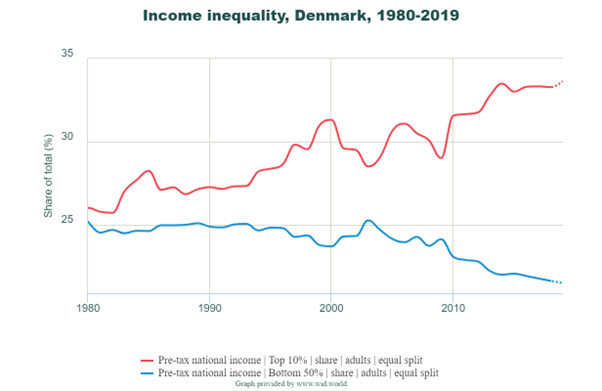
But inequality of wealth is even worse – as it is in Norway and Sweden. The rule of the wealthy and big capital (often controlled by a few mega rich families) is a feature. The bottom 50% of adults in Denmark have less than 5% of total personal wealth while the top 10% have 50% and the top 1% over 20%. Social democracy is more a name than reality.
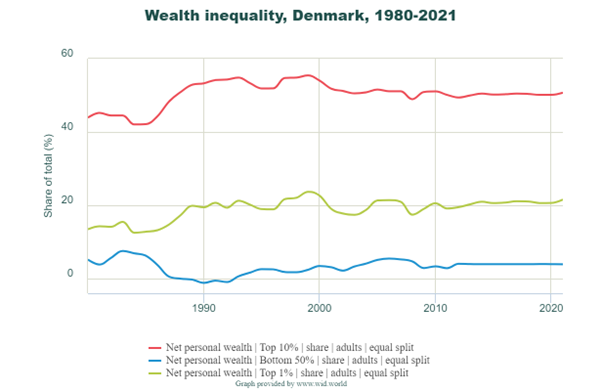
The small Danish economy usually does better than most in the EU. Average real GDP growth has been higher than the EU average and the impact of the COVID slump less.
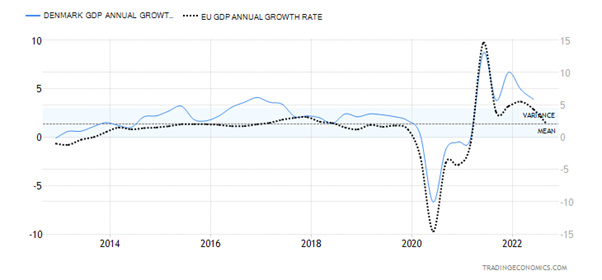
But Denmark is not escaping the general malaise in the world economy as inflation rates rocket and interest rates rise.
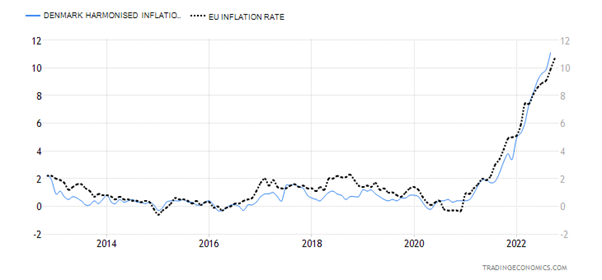
The house price boom in Denmark (as in other EU countries) that has boosted middle-class wealth is about to take a turn down.
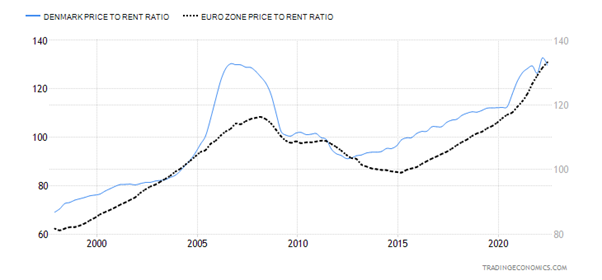
Another round of fiscal austerity and welfare cuts will be on the agenda of any ‘national’ government. Danish business is beginning to struggle and profitability is set to fall.
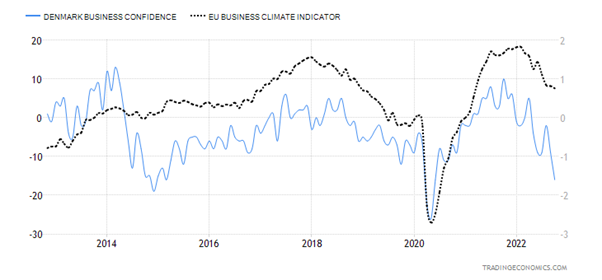
And it is the long-term decline in profitability that has set the base for the gradual reduction in the social democratic model in the last 40 years.
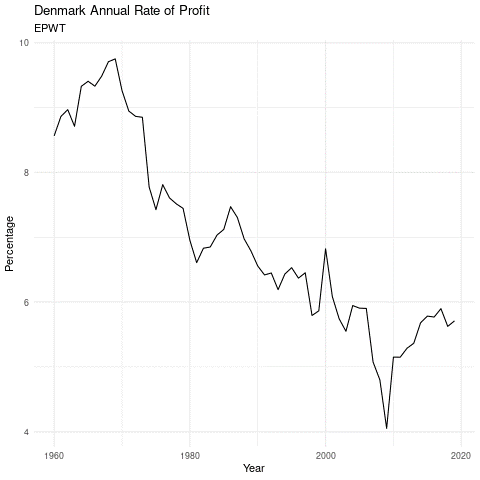
Thanks very much Michael. Just in time. Since you unfortunately could not come to our Marxism Conference 11-12. November i Copenhagen, this is very useful for us in the International Socialists and for the left in general.
You may be interested in this article (today), in which the SNP, also drifting neo-liberal rightwards, is showing new interest in the Nordic countries, perhaps now that they are all demonstrating their neo-lib, NATO credentials.
The SNP is in real trouble, losing membership and unable to map out a strategy for anything, let alone currency, a subject the left is working hard on. (Perhaps worth your good councel?). In fact, other than on independence, it is steadily following the route set out by Scottish Labour.
This is the National’s ‘copy and paste’ blurb.
I saw this The National article on the The National app and thought you’d be interested. Scotland urged to build links with Nordic countries as UK puts up walls https://www.thenational.scot/news/23093990.scotland-told-boost-ties-nordic-countries-uk-isolates/?ref=psapp For more great content like this subscribe to the The National app here: https://www.thenational.scot/subscribe/
Much appreciate your work, thanks.
Gordon
Denmark is such a small country by capitalist standards that it is difficult to draw any significant macroeconomic conclusions. The statistical distortion is simply too high.
Thanks for this Michael. But you are wrong on the “the two partys to the left of the SD losing ground.” This is true of the Left Unity List (Enhedslisten) who lost 4 members of parlament and are left with 9. They are the most left of the two left reformist partys. The other, the Peoples Socialist Party actually gained a member. Together with the green Alternative party the three parties, together make up about 16% of the popular vote. About the same as they had before but distributed a little different with what is considered the “extreme left” losing support.
As long as capital exists, and plays its disintegrating role, any gains by the working classes will be whittled away. Nordic social democracy was won by mass Communist and Socialist Party activism. But as capital degrades and can no longer provide a decent social-safety net, this is moot. Capital has to be removed from power, both political and economic, for actual stability for the working classes to exist. The same is true in the U.S. It seems far-fetched at this point, but ultimately it will be the only rational move.
Thanks Michael for your perceptive piece on the recent Danish general election – just one little correction the anti-immigrant party that has imploded is not the Democrats but the Danish People`s Party (DF – Det Dansk Folkparti) which only managed to get 2.6% of the vote and is now reduced from 16 MPs to just 5. As you write, the Social Democrats undercut DF (not the Democrats’) support by largely adopting their anti-immigrant policies combined with a crude ´Danes first` (the ´the little people` – ´ordinary Danish people/workers`) rhetoric. It was the Danish Social Democrats that first mooted (before the British Conservative) the idea of sending asylum seekers to incarceration abroad, specifically Rwanda. The extreme racism has been taken-up by two relatively new political parties running on a platform of full-blooded neoliberalism/right wing libertarianism with a demand for a reduction in taxation: Liberal Alliance (LA) and the Denmark Democrats (Danmarksdemokraterne -DD). Both these unpleasant parties had a good election, with the DD, in their first general election, winning 8.1% of the vote and 14 MPS and LA achieving just under 8% and increasing the number of their MPs from 4 to 14. In contrast to DF both these parties seem to get significant support from young middle class professionals and business students. Clearly DD and LA have taken away votes from the more traditional right wing parties – Denmark`s Liberal Party (the main right wing/bourgeois party) and the Conservative People`s Party. The Liberal Party was also hit by a new split-off party, the Moderates (Moderaterne – M), led by a former Liberal Party prime minister – a party, which is very much the personal vanity project of a compromised (outstanding cases of petty corruption/freebies) politician – that the Social Democrats are attempting to pull into a new coalition government.
One extra comment about the election – something I found quite dispiriting – was that the issue of peace was simply not raised. The left didn`t differentiate itself from the Social Democrats or right wing generally as far as the Ukraine war goes – pro-NATO, no call for peace talks, sending a constant stream of armaments to the Ukrainian government etc.
Denmark is one of the few remaining (yet indeed declining) actual social democracies. I would be reluctant to call it merely a capitalist economy, as you do in this article; and that it is a social democracy seems to me to be a reality and not just a name.
Here are three things to take into consideration:
1. The income inequality before taxes is actually lower than the one you portray in the article. The bottom 50% earns more than 20% of the total income. Even the graph that you include, if read correctly, shows that.
2. The income inequality after taxes, which I think we can agree it is more important, is even lower. The bottom 50% gets almost 30% of the total income and the top 10% gets less than 30%.
3. Wealth inequality is indeed as much as you show, but it seems that you forget that it refers to the private wealth and not the total wealth of society. The private wealth per capita in Denmark is much lower than it is in many other actual capitalist societies, and this is precisely because of the welfare state.
Source: https://wid.world/country/denmark/